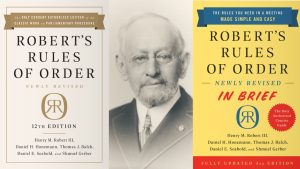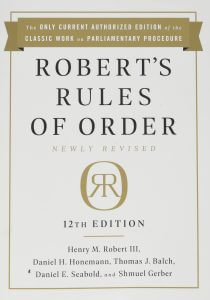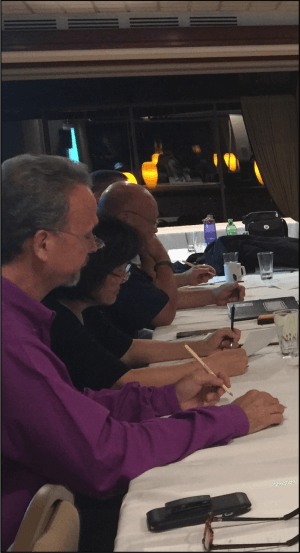
USJF Education Portal
Robert Rules of Order
 Robert’s Rules of Order is a manual of parliamentary procedure that governs most organizations with boards of directors. In 1876, Henry Martyn Robert adapted the rules and practices of Congress to the needs of non-legislative bodies and wrote them in his book, which is still in use today. The Robert’s Rules Association published brief versions of the book in 2005 and 2011.
Robert’s Rules of Order is a manual of parliamentary procedure that governs most organizations with boards of directors. In 1876, Henry Martyn Robert adapted the rules and practices of Congress to the needs of non-legislative bodies and wrote them in his book, which is still in use today. The Robert’s Rules Association published brief versions of the book in 2005 and 2011.


Learning Outcomes
At the conclusion of the course, you will be able to;
-
- Interpret and apply basic principles of parliamentary procedures in meetings.
- Demonstrate ability to preside over meetings and employ the rules in parliamentary debate
- Recognize and apply basic knowledge of the most important motions; debate, amend, withdraw, refer to committee, postpone indefinitely, reconsider, rescind, amend a previously adopted motion and voting.
Introduction to Robert Rules of Order
Robert’s Rules of Order provides applicable rules governing key matters of meeting and general procedures, including:
- Establishing a Constitution and Bylaws for the organization.
- Structure of the meeting Agenda and debate.
- Motions; including making, seconding, debating, modifying and amending motions.
- Sufficient majority and simple majority and which decisions are appropriate to them.
- Establishment of a quorum.
- Definition of membership.
- Voting rights of presiding officer and voting procedures.
Module 1 - Basic Parliamentary procedures
- Rules governing an organization
- Purposes of Parliamentary Procedure
- Basic Principles of Parliamentary Procedure
- Typical Order of Business
- Role of the Presiding Officer
- General Procedure for Handling a Motion
- General Rules of Debate
Module 2: Motions
- Motions in Ascending Order of Precedence
- Pending motions must be disposed of in descending order of precedence.
- Main Motion
Module 3: Subsidiary Motions
- Postpone Indefinitely
- Amend
- Motion to Substitute
- Secondary Amendment
- Refer (Commit)
- Postpone Definitely (Postpone to a Certain Time)
- Limit or Extend Debate
- Previous Question (“Call for the Question”)
- Lay on the Table
Module 4: Privileged Motions
Privileged Motions
- Call for the Orders of the Day
- Raise a Question of Privilege
- Recess
- Adjourn
- Fix the Time to Which to Adjourn
Module 5: Incidental Motions
Incidental Motions
- Point of Order
- Appeal
- Suspend the Rules
- Withdraw
- Point of Information
- Objection to the Consideration of a Question
- Division of a Question
- Division of the Assembly
Module 6: Main Motions That Bring a Question Back
Main Motions That Bring a Question Back Before the Assembly
- Take from the Table
- Reconsider
- Rescind (Annul or Repeal)
Module 7: Voting
Voting
- Majority vote
- Two-thirds vote
- Voting by the Chair
- Methods of Voting
- Voice vote
- Show of hands or rising vote
- Ballot
- Roll call vote
- Proxy voting
Module 8: Reference Robert Rules
Yoko-sutemi-waza (Side Sacrifice Techniques)
- Yoko gake (Side hook)
- Yoko guruma (Side wheel)
- Uki waza (Floating technique)
Module 9: Reference Robert Rules Cheat Sheet

